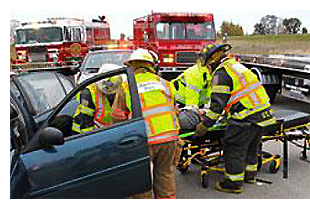
Pilot study in Boise demonstrates use of CrashHelp system
University of Minnesota Center for Excellence in Rural Safety
Rural Safety News
(From Quick Notes by Brent Jennings)
In an ongoing effort to facilitate communication and improve patient care following traffic crashes, researchers with CERS and the Intelligent Transportation Systems (ITS) Institute have completed a pilot study of the prototype CrashHelp system. Overall results were positive, indicating that CrashHelp allowed for the efficient collection of usable information.
 CrashHelp is a smartphone-based system that enables emergency responders to collect multimedia data about crash victims on-scene and send it directly into emergency rooms, providing hospitals with advance notification of crash severity and related information that can be used to best prepare for a patient’s arrival.
CrashHelp is a smartphone-based system that enables emergency responders to collect multimedia data about crash victims on-scene and send it directly into emergency rooms, providing hospitals with advance notification of crash severity and related information that can be used to best prepare for a patient’s arrival.
Tom Horan, CERS research director, reviewed the results of the pilot study in a recent CERS webinar. The study—conducted from July through October 2011 in Boise, Idaho—included six hospitals and two ambulance providers.
During the pilot, ambulance crew paramedics and emergency medical technicians used a CrashHelp-equipped smartphone to securely capture pictures, digital audio recordings, video, and basic patient and incident information.
The information was then sent to the participating hospital, where an automated phone call informed hospital personnel that new incident information was available for viewing on CrashHelp’s web-based interface. An acknowledgement was sent to the medic after the file had been accessed, and the medic could then send any additional information via text message.
A total of 801 incident transmittals were completed during the study period, including more than 400 images and nearly 450 audio recordings. Horan said the researchers had anticipated images being used most frequently and were surprised by the popularity of the audio recordings. The consistent use of audio could be because emergency responders are most comfortable with this type of reporting since they provide similar verbal reports to emergency departments over the radio.
The researchers also found that use of the system varied widely between more technically savvy personnel and those who didn’t know how to make the best use of the system. óMoving forward, we see the need to do more training in order to get a full range of proficiency, Horan said.
 The researchers also conducted follow-up focus groups with personnel from participating hospitals and ambulance providers, state EMS agencies, and the Idaho Department of Transportation. Medics reported that seeing the information being used in hospitals drove them to make more use of the system, and hospital personnel said the information they received helped them prepare for a patient’s arrival—especially for those coming from further away.
The researchers also conducted follow-up focus groups with personnel from participating hospitals and ambulance providers, state EMS agencies, and the Idaho Department of Transportation. Medics reported that seeing the information being used in hospitals drove them to make more use of the system, and hospital personnel said the information they received helped them prepare for a patient’s arrival—especially for those coming from further away.
The study also helped the researchers identify future needs, such as protocol on how many and what types of pictures would provide the most value to emergency room personnel. There is also interest in additional notification types, such as an automated phone call that plays the available audio message automatically for hospital personnel.
Idaho has expressed interest in extending the pilot and expanding coverage to a rural area, Horan said. The researchers are also planning a pilot effort in St. Cloud, Minn., where they will investigate how CrashHelp could be used as part of a hospital-to-hospital referral system.
Published 5-25-2012